Sociology Essay: Race, Ethnicity, Inequalities, and Social Constructs
VerifiedAdded on 2023/04/21
|13
|3193
|75
Essay
AI Summary
This essay delves into the multifaceted concepts of race and ethnicity, distinguishing between their biological and sociological dimensions. It explores race as a biological and social construct, analyzing the historical and contemporary perspectives on racial classification and its limitations. The essay further examines inequalities among ethnic groups, highlighting disparities in various aspects of life, such as employment, education, and health within the UK context. It then provides sociological explanations for these inequalities, drawing upon functionalist, Marxist, and Weberian perspectives to understand the dynamics of social stratification and the role of ethnic minority groups within the workforce. The essay concludes by discussing the implications of these sociological theories in explaining the persistent racial and ethnic disparities observed in society.

Running Head: RACE AND ETHNICITY
0
Race and Ethnicity
Student Name
0
Race and Ethnicity
Student Name
Paraphrase This Document
Need a fresh take? Get an instant paraphrase of this document with our AI Paraphraser

RACE AND ETHNICITY
1
Table of Contents
Introduction...........................................................................................................................................2
Difference between race and ethnicity...............................................................................................2
Race as biological and social construct..............................................................................................4
Inequalities among ethnic groups......................................................................................................6
Sociological explanations..................................................................................................................7
References...........................................................................................................................................10
1
Table of Contents
Introduction...........................................................................................................................................2
Difference between race and ethnicity...............................................................................................2
Race as biological and social construct..............................................................................................4
Inequalities among ethnic groups......................................................................................................6
Sociological explanations..................................................................................................................7
References...........................................................................................................................................10
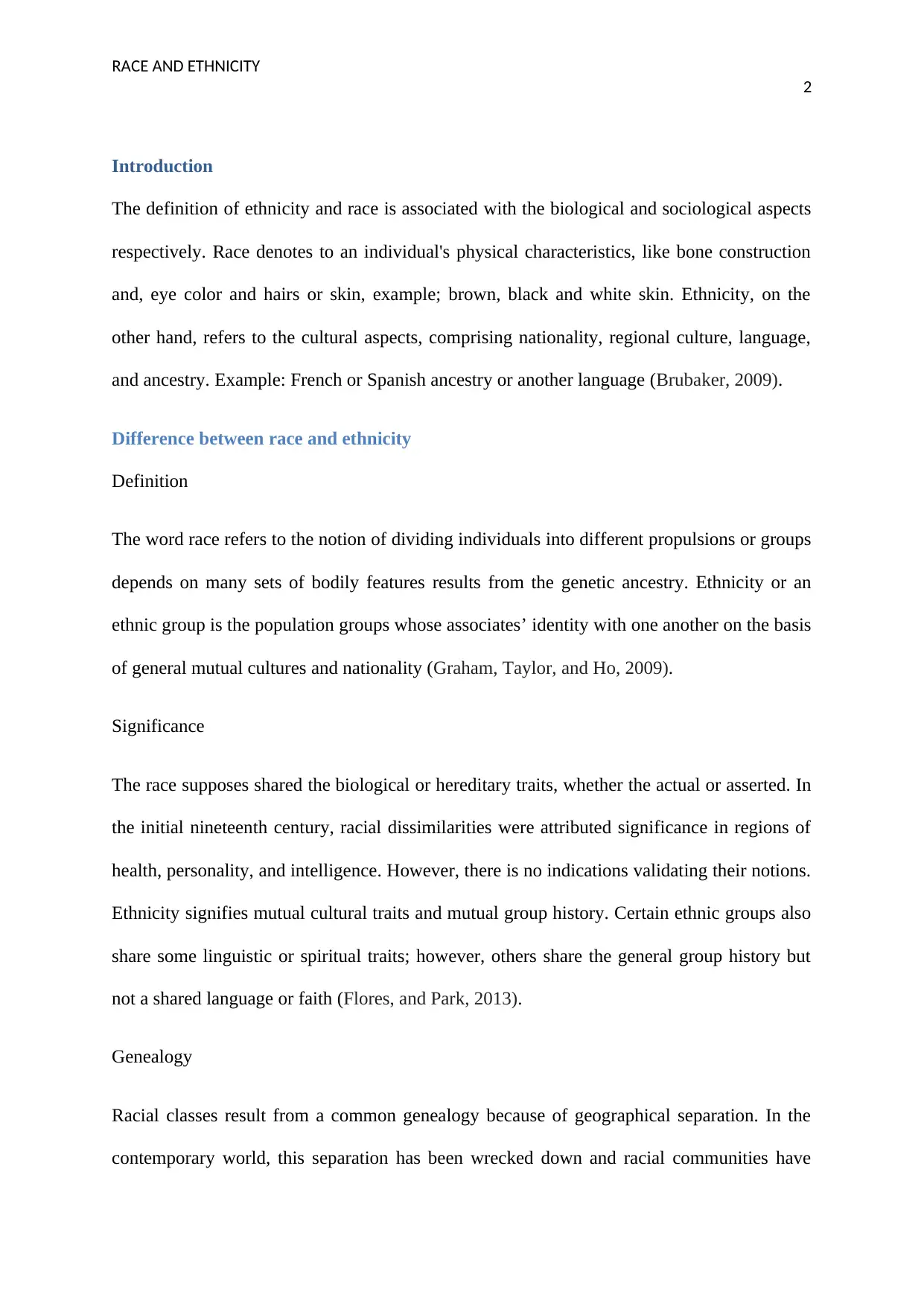
RACE AND ETHNICITY
2
Introduction
The definition of ethnicity and race is associated with the biological and sociological aspects
respectively. Race denotes to an individual's physical characteristics, like bone construction
and, eye color and hairs or skin, example; brown, black and white skin. Ethnicity, on the
other hand, refers to the cultural aspects, comprising nationality, regional culture, language,
and ancestry. Example: French or Spanish ancestry or another language (Brubaker, 2009).
Difference between race and ethnicity
Definition
The word race refers to the notion of dividing individuals into different propulsions or groups
depends on many sets of bodily features results from the genetic ancestry. Ethnicity or an
ethnic group is the population groups whose associates’ identity with one another on the basis
of general mutual cultures and nationality (Graham, Taylor, and Ho, 2009).
Significance
The race supposes shared the biological or hereditary traits, whether the actual or asserted. In
the initial nineteenth century, racial dissimilarities were attributed significance in regions of
health, personality, and intelligence. However, there is no indications validating their notions.
Ethnicity signifies mutual cultural traits and mutual group history. Certain ethnic groups also
share some linguistic or spiritual traits; however, others share the general group history but
not a shared language or faith (Flores, and Park, 2013).
Genealogy
Racial classes result from a common genealogy because of geographical separation. In the
contemporary world, this separation has been wrecked down and racial communities have
2
Introduction
The definition of ethnicity and race is associated with the biological and sociological aspects
respectively. Race denotes to an individual's physical characteristics, like bone construction
and, eye color and hairs or skin, example; brown, black and white skin. Ethnicity, on the
other hand, refers to the cultural aspects, comprising nationality, regional culture, language,
and ancestry. Example: French or Spanish ancestry or another language (Brubaker, 2009).
Difference between race and ethnicity
Definition
The word race refers to the notion of dividing individuals into different propulsions or groups
depends on many sets of bodily features results from the genetic ancestry. Ethnicity or an
ethnic group is the population groups whose associates’ identity with one another on the basis
of general mutual cultures and nationality (Graham, Taylor, and Ho, 2009).
Significance
The race supposes shared the biological or hereditary traits, whether the actual or asserted. In
the initial nineteenth century, racial dissimilarities were attributed significance in regions of
health, personality, and intelligence. However, there is no indications validating their notions.
Ethnicity signifies mutual cultural traits and mutual group history. Certain ethnic groups also
share some linguistic or spiritual traits; however, others share the general group history but
not a shared language or faith (Flores, and Park, 2013).
Genealogy
Racial classes result from a common genealogy because of geographical separation. In the
contemporary world, this separation has been wrecked down and racial communities have
⊘ This is a preview!⊘
Do you want full access?
Subscribe today to unlock all pages.

Trusted by 1+ million students worldwide
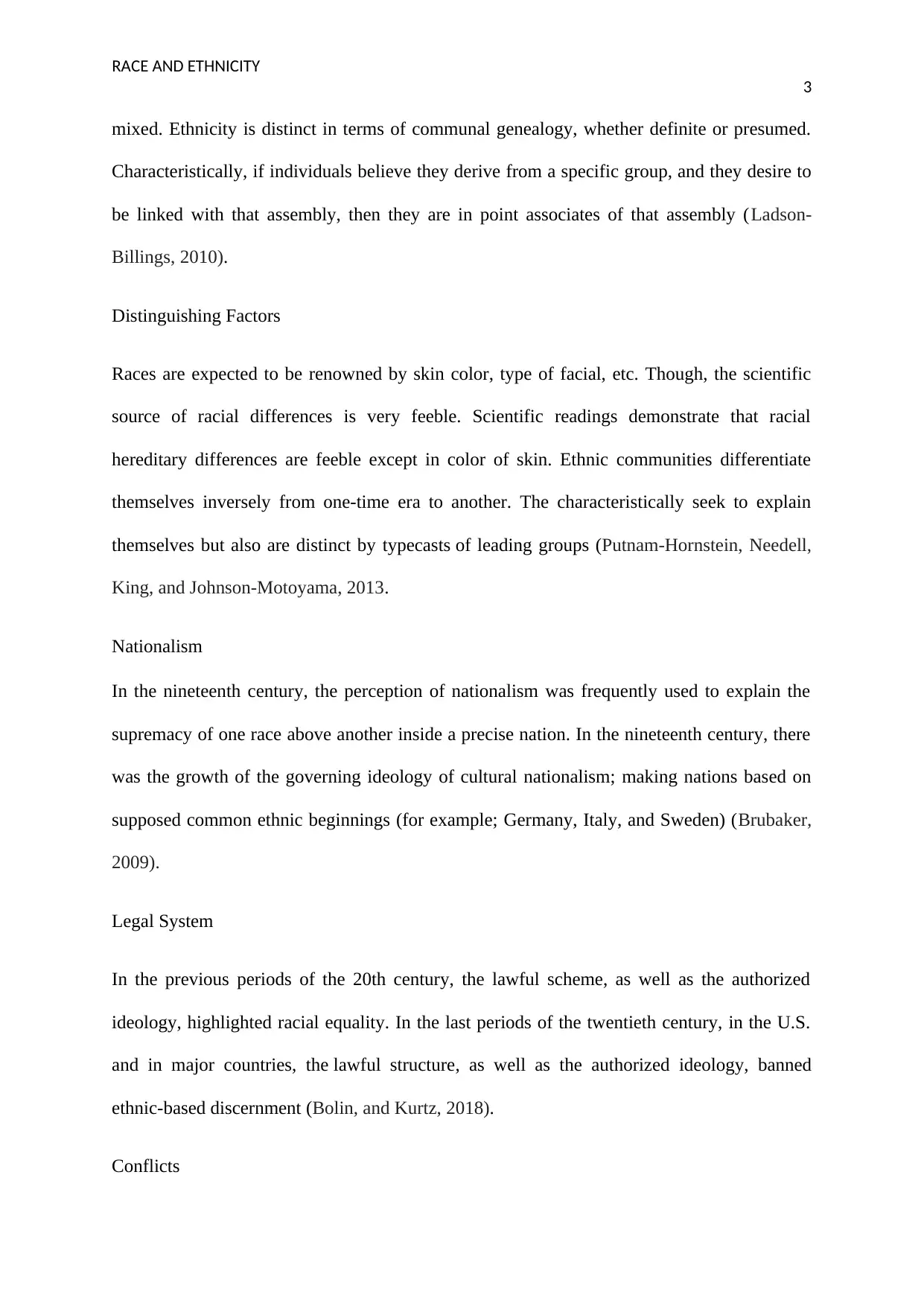
RACE AND ETHNICITY
3
mixed. Ethnicity is distinct in terms of communal genealogy, whether definite or presumed.
Characteristically, if individuals believe they derive from a specific group, and they desire to
be linked with that assembly, then they are in point associates of that assembly (Ladson-
Billings, 2010).
Distinguishing Factors
Races are expected to be renowned by skin color, type of facial, etc. Though, the scientific
source of racial differences is very feeble. Scientific readings demonstrate that racial
hereditary differences are feeble except in color of skin. Ethnic communities differentiate
themselves inversely from one-time era to another. The characteristically seek to explain
themselves but also are distinct by typecasts of leading groups (Putnam-Hornstein, Needell,
King, and Johnson-Motoyama, 2013.
Nationalism
In the nineteenth century, the perception of nationalism was frequently used to explain the
supremacy of one race above another inside a precise nation. In the nineteenth century, there
was the growth of the governing ideology of cultural nationalism; making nations based on
supposed common ethnic beginnings (for example; Germany, Italy, and Sweden) (Brubaker,
2009).
Legal System
In the previous periods of the 20th century, the lawful scheme, as well as the authorized
ideology, highlighted racial equality. In the last periods of the twentieth century, in the U.S.
and in major countries, the lawful structure, as well as the authorized ideology, banned
ethnic-based discernment (Bolin, and Kurtz, 2018).
Conflicts
3
mixed. Ethnicity is distinct in terms of communal genealogy, whether definite or presumed.
Characteristically, if individuals believe they derive from a specific group, and they desire to
be linked with that assembly, then they are in point associates of that assembly (Ladson-
Billings, 2010).
Distinguishing Factors
Races are expected to be renowned by skin color, type of facial, etc. Though, the scientific
source of racial differences is very feeble. Scientific readings demonstrate that racial
hereditary differences are feeble except in color of skin. Ethnic communities differentiate
themselves inversely from one-time era to another. The characteristically seek to explain
themselves but also are distinct by typecasts of leading groups (Putnam-Hornstein, Needell,
King, and Johnson-Motoyama, 2013.
Nationalism
In the nineteenth century, the perception of nationalism was frequently used to explain the
supremacy of one race above another inside a precise nation. In the nineteenth century, there
was the growth of the governing ideology of cultural nationalism; making nations based on
supposed common ethnic beginnings (for example; Germany, Italy, and Sweden) (Brubaker,
2009).
Legal System
In the previous periods of the 20th century, the lawful scheme, as well as the authorized
ideology, highlighted racial equality. In the last periods of the twentieth century, in the U.S.
and in major countries, the lawful structure, as well as the authorized ideology, banned
ethnic-based discernment (Bolin, and Kurtz, 2018).
Conflicts
Paraphrase This Document
Need a fresh take? Get an instant paraphrase of this document with our AI Paraphraser
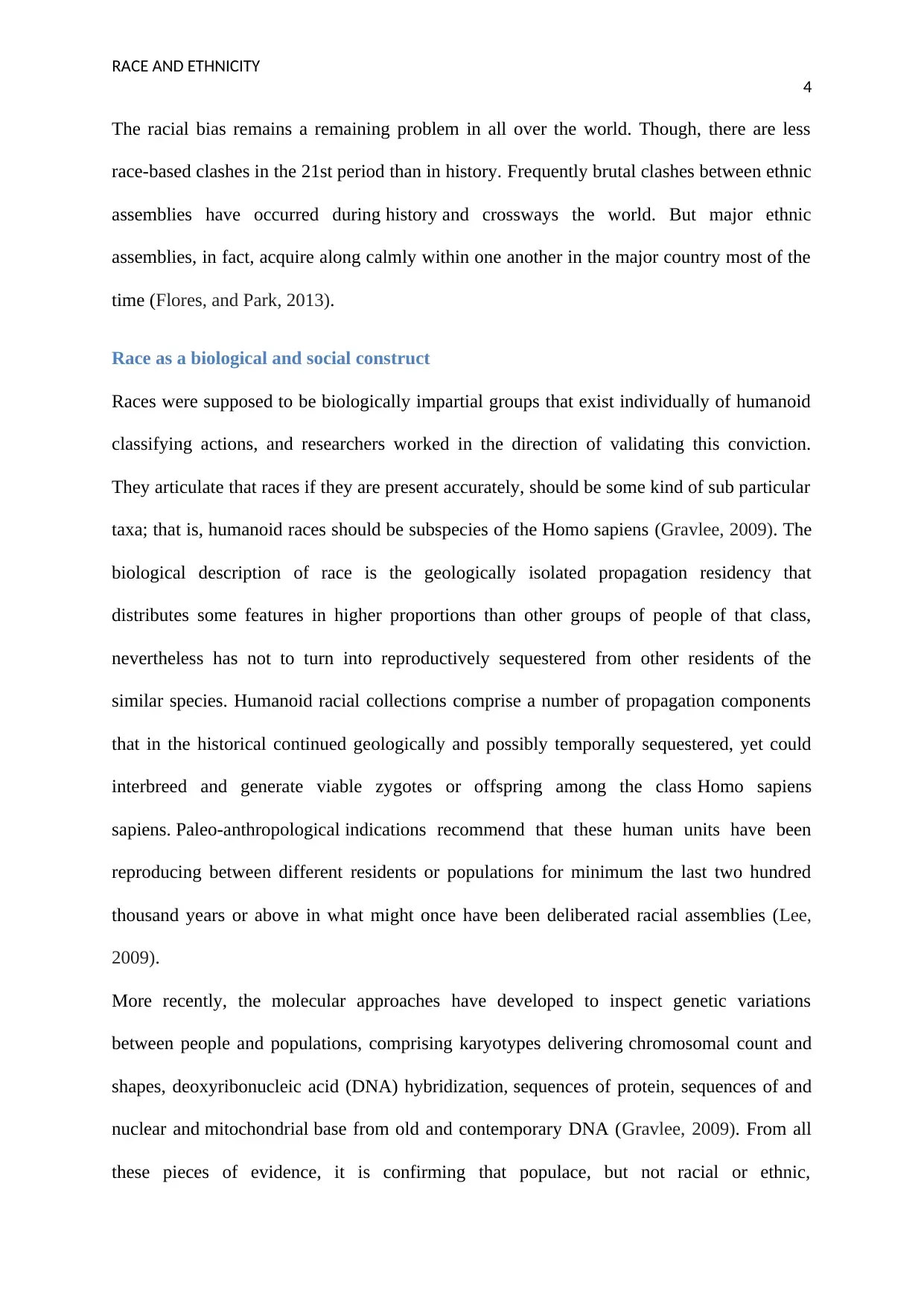
RACE AND ETHNICITY
4
The racial bias remains a remaining problem in all over the world. Though, there are less
race-based clashes in the 21st period than in history. Frequently brutal clashes between ethnic
assemblies have occurred during history and crossways the world. But major ethnic
assemblies, in fact, acquire along calmly within one another in the major country most of the
time (Flores, and Park, 2013).
Race as a biological and social construct
Races were supposed to be biologically impartial groups that exist individually of humanoid
classifying actions, and researchers worked in the direction of validating this conviction.
They articulate that races if they are present accurately, should be some kind of sub particular
taxa; that is, humanoid races should be subspecies of the Homo sapiens (Gravlee, 2009). The
biological description of race is the geologically isolated propagation residency that
distributes some features in higher proportions than other groups of people of that class,
nevertheless has not to turn into reproductively sequestered from other residents of the
similar species. Humanoid racial collections comprise a number of propagation components
that in the historical continued geologically and possibly temporally sequestered, yet could
interbreed and generate viable zygotes or offspring among the class Homo sapiens
sapiens. Paleo-anthropological indications recommend that these human units have been
reproducing between different residents or populations for minimum the last two hundred
thousand years or above in what might once have been deliberated racial assemblies (Lee,
2009).
More recently, the molecular approaches have developed to inspect genetic variations
between people and populations, comprising karyotypes delivering chromosomal count and
shapes, deoxyribonucleic acid (DNA) hybridization, sequences of protein, sequences of and
nuclear and mitochondrial base from old and contemporary DNA (Gravlee, 2009). From all
these pieces of evidence, it is confirming that populace, but not racial or ethnic,
4
The racial bias remains a remaining problem in all over the world. Though, there are less
race-based clashes in the 21st period than in history. Frequently brutal clashes between ethnic
assemblies have occurred during history and crossways the world. But major ethnic
assemblies, in fact, acquire along calmly within one another in the major country most of the
time (Flores, and Park, 2013).
Race as a biological and social construct
Races were supposed to be biologically impartial groups that exist individually of humanoid
classifying actions, and researchers worked in the direction of validating this conviction.
They articulate that races if they are present accurately, should be some kind of sub particular
taxa; that is, humanoid races should be subspecies of the Homo sapiens (Gravlee, 2009). The
biological description of race is the geologically isolated propagation residency that
distributes some features in higher proportions than other groups of people of that class,
nevertheless has not to turn into reproductively sequestered from other residents of the
similar species. Humanoid racial collections comprise a number of propagation components
that in the historical continued geologically and possibly temporally sequestered, yet could
interbreed and generate viable zygotes or offspring among the class Homo sapiens
sapiens. Paleo-anthropological indications recommend that these human units have been
reproducing between different residents or populations for minimum the last two hundred
thousand years or above in what might once have been deliberated racial assemblies (Lee,
2009).
More recently, the molecular approaches have developed to inspect genetic variations
between people and populations, comprising karyotypes delivering chromosomal count and
shapes, deoxyribonucleic acid (DNA) hybridization, sequences of protein, sequences of and
nuclear and mitochondrial base from old and contemporary DNA (Gravlee, 2009). From all
these pieces of evidence, it is confirming that populace, but not racial or ethnic,
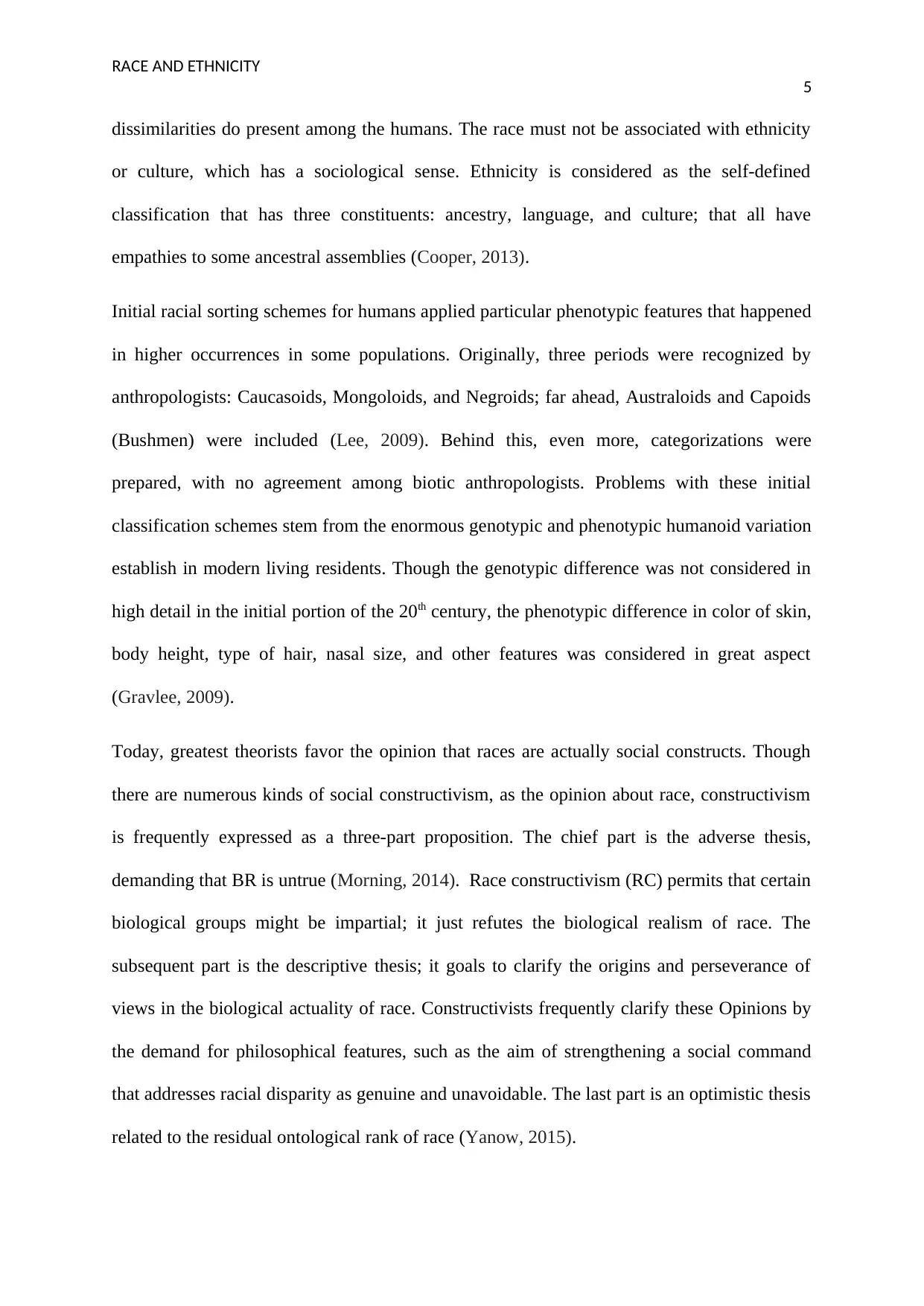
RACE AND ETHNICITY
5
dissimilarities do present among the humans. The race must not be associated with ethnicity
or culture, which has a sociological sense. Ethnicity is considered as the self-defined
classification that has three constituents: ancestry, language, and culture; that all have
empathies to some ancestral assemblies (Cooper, 2013).
Initial racial sorting schemes for humans applied particular phenotypic features that happened
in higher occurrences in some populations. Originally, three periods were recognized by
anthropologists: Caucasoids, Mongoloids, and Negroids; far ahead, Australoids and Capoids
(Bushmen) were included (Lee, 2009). Behind this, even more, categorizations were
prepared, with no agreement among biotic anthropologists. Problems with these initial
classification schemes stem from the enormous genotypic and phenotypic humanoid variation
establish in modern living residents. Though the genotypic difference was not considered in
high detail in the initial portion of the 20th century, the phenotypic difference in color of skin,
body height, type of hair, nasal size, and other features was considered in great aspect
(Gravlee, 2009).
Today, greatest theorists favor the opinion that races are actually social constructs. Though
there are numerous kinds of social constructivism, as the opinion about race, constructivism
is frequently expressed as a three-part proposition. The chief part is the adverse thesis,
demanding that BR is untrue (Morning, 2014). Race constructivism (RC) permits that certain
biological groups might be impartial; it just refutes the biological realism of race. The
subsequent part is the descriptive thesis; it goals to clarify the origins and perseverance of
views in the biological actuality of race. Constructivists frequently clarify these Opinions by
the demand for philosophical features, such as the aim of strengthening a social command
that addresses racial disparity as genuine and unavoidable. The last part is an optimistic thesis
related to the residual ontological rank of race (Yanow, 2015).
5
dissimilarities do present among the humans. The race must not be associated with ethnicity
or culture, which has a sociological sense. Ethnicity is considered as the self-defined
classification that has three constituents: ancestry, language, and culture; that all have
empathies to some ancestral assemblies (Cooper, 2013).
Initial racial sorting schemes for humans applied particular phenotypic features that happened
in higher occurrences in some populations. Originally, three periods were recognized by
anthropologists: Caucasoids, Mongoloids, and Negroids; far ahead, Australoids and Capoids
(Bushmen) were included (Lee, 2009). Behind this, even more, categorizations were
prepared, with no agreement among biotic anthropologists. Problems with these initial
classification schemes stem from the enormous genotypic and phenotypic humanoid variation
establish in modern living residents. Though the genotypic difference was not considered in
high detail in the initial portion of the 20th century, the phenotypic difference in color of skin,
body height, type of hair, nasal size, and other features was considered in great aspect
(Gravlee, 2009).
Today, greatest theorists favor the opinion that races are actually social constructs. Though
there are numerous kinds of social constructivism, as the opinion about race, constructivism
is frequently expressed as a three-part proposition. The chief part is the adverse thesis,
demanding that BR is untrue (Morning, 2014). Race constructivism (RC) permits that certain
biological groups might be impartial; it just refutes the biological realism of race. The
subsequent part is the descriptive thesis; it goals to clarify the origins and perseverance of
views in the biological actuality of race. Constructivists frequently clarify these Opinions by
the demand for philosophical features, such as the aim of strengthening a social command
that addresses racial disparity as genuine and unavoidable. The last part is an optimistic thesis
related to the residual ontological rank of race (Yanow, 2015).
⊘ This is a preview!⊘
Do you want full access?
Subscribe today to unlock all pages.

Trusted by 1+ million students worldwide

RACE AND ETHNICITY
6
Inequalities among ethnic groups
Deep-seated racial dissimilarity in the UK has been placed bare in a novel report revealing
"entrenched" differences between dissimilar ethnic groups. Significant variances in the live
results of British cultural minority and white persons exposed in the Administration’s racial
inequality audit have encouraged experts to urge organizations to help make sure race is
certainly not an obstacle (Jackson, Jonsson, and Rudolphi, 2012). A considerably advanced
joblessness rate between black, Asian and marginal ethnic persons than white British grown-
ups and inferior home possession amongst Bangladeshis and black persons are among the
results to be exposed. Specifically, in the UK, there is a 12 percent occupation gap among
white British and cultural minority persons. This amounts to about 500,000 “misplaced”
workforces in the UK workforce market (Knight, Kurinczuk, Spark, and Brocklehurst, 2009).
Statistics from the Subdivision for Work and Annuities display an unemployed rate of 45
percent in 2013 for adult black, Pakistani and Bangladeshi labors, with a percentage of 19%
for white persons. Dark skinned Caribbean learners were forever debarred at three times the
degree (0.29 percent) of white British learners (0.1 percent). The joblessness rate for dark-
skinned people, Asian and marginal ethnic persons (8 percent) is closely twice that of white
British grown-ups (4.6 percent), with the greater gap in the Northern (13.6 percent) than the
Southern (9 percent) (Knight et al., 2009).
White British scholars have the uppermost opportunity of being presented a place, with 52
percent of applicants receiving proposals, though Black African learners have the lowermost
opportunity, with only 35 percent of applicants receiving proposals of seats (Heath, and
Martin, 2013).
In England, the word ‘health disparities’ is usually agreed to mean dissimilarities in health
position between dissimilar population societies that are partial and preventable. Ethnic
6
Inequalities among ethnic groups
Deep-seated racial dissimilarity in the UK has been placed bare in a novel report revealing
"entrenched" differences between dissimilar ethnic groups. Significant variances in the live
results of British cultural minority and white persons exposed in the Administration’s racial
inequality audit have encouraged experts to urge organizations to help make sure race is
certainly not an obstacle (Jackson, Jonsson, and Rudolphi, 2012). A considerably advanced
joblessness rate between black, Asian and marginal ethnic persons than white British grown-
ups and inferior home possession amongst Bangladeshis and black persons are among the
results to be exposed. Specifically, in the UK, there is a 12 percent occupation gap among
white British and cultural minority persons. This amounts to about 500,000 “misplaced”
workforces in the UK workforce market (Knight, Kurinczuk, Spark, and Brocklehurst, 2009).
Statistics from the Subdivision for Work and Annuities display an unemployed rate of 45
percent in 2013 for adult black, Pakistani and Bangladeshi labors, with a percentage of 19%
for white persons. Dark skinned Caribbean learners were forever debarred at three times the
degree (0.29 percent) of white British learners (0.1 percent). The joblessness rate for dark-
skinned people, Asian and marginal ethnic persons (8 percent) is closely twice that of white
British grown-ups (4.6 percent), with the greater gap in the Northern (13.6 percent) than the
Southern (9 percent) (Knight et al., 2009).
White British scholars have the uppermost opportunity of being presented a place, with 52
percent of applicants receiving proposals, though Black African learners have the lowermost
opportunity, with only 35 percent of applicants receiving proposals of seats (Heath, and
Martin, 2013).
In England, the word ‘health disparities’ is usually agreed to mean dissimilarities in health
position between dissimilar population societies that are partial and preventable. Ethnic
Paraphrase This Document
Need a fresh take? Get an instant paraphrase of this document with our AI Paraphraser
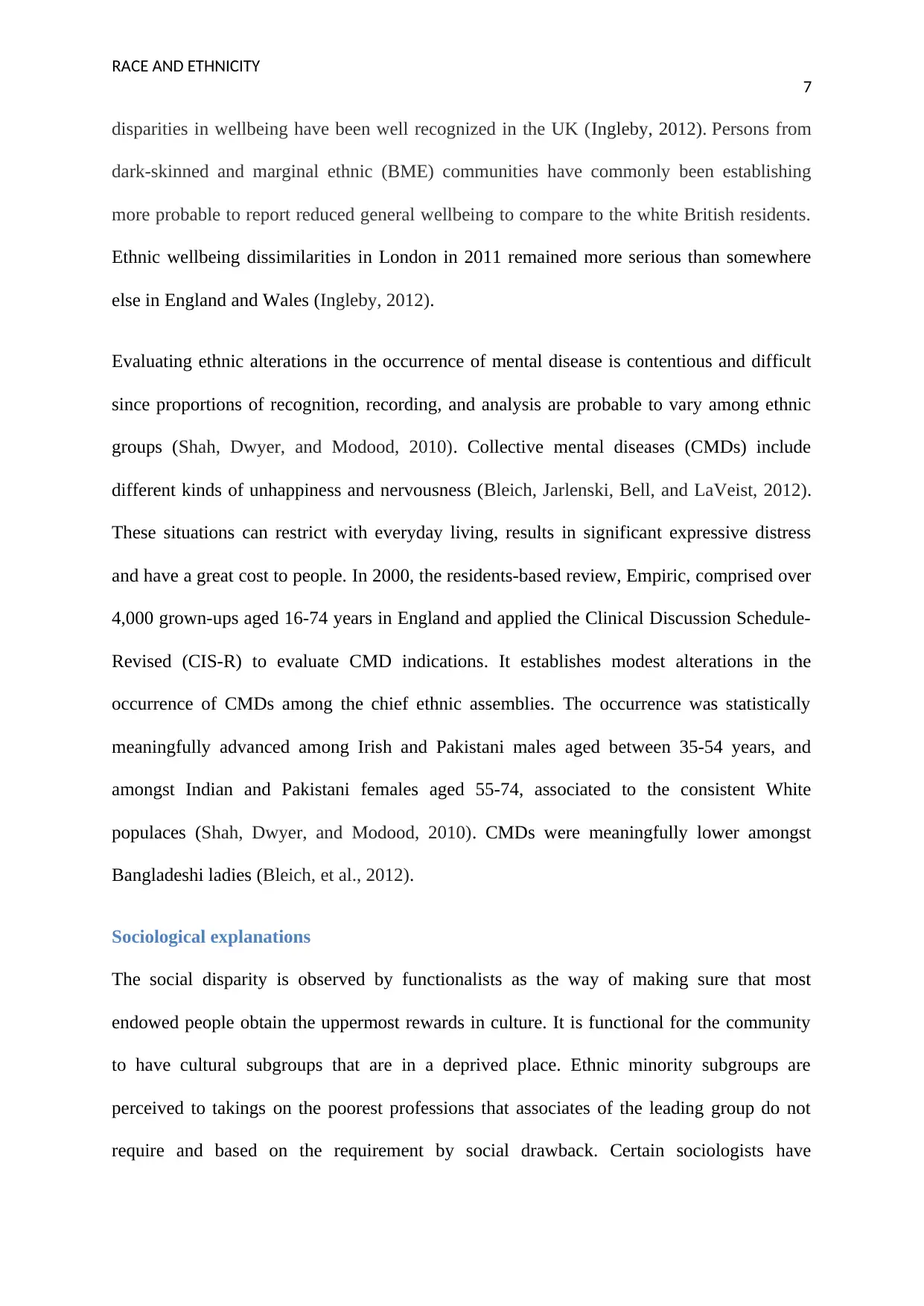
RACE AND ETHNICITY
7
disparities in wellbeing have been well recognized in the UK (Ingleby, 2012). Persons from
dark-skinned and marginal ethnic (BME) communities have commonly been establishing
more probable to report reduced general wellbeing to compare to the white British residents.
Ethnic wellbeing dissimilarities in London in 2011 remained more serious than somewhere
else in England and Wales (Ingleby, 2012).
Evaluating ethnic alterations in the occurrence of mental disease is contentious and difficult
since proportions of recognition, recording, and analysis are probable to vary among ethnic
groups (Shah, Dwyer, and Modood, 2010). Collective mental diseases (CMDs) include
different kinds of unhappiness and nervousness (Bleich, Jarlenski, Bell, and LaVeist, 2012).
These situations can restrict with everyday living, results in significant expressive distress
and have a great cost to people. In 2000, the residents-based review, Empiric, comprised over
4,000 grown-ups aged 16-74 years in England and applied the Clinical Discussion Schedule-
Revised (CIS-R) to evaluate CMD indications. It establishes modest alterations in the
occurrence of CMDs among the chief ethnic assemblies. The occurrence was statistically
meaningfully advanced among Irish and Pakistani males aged between 35-54 years, and
amongst Indian and Pakistani females aged 55-74, associated to the consistent White
populaces (Shah, Dwyer, and Modood, 2010). CMDs were meaningfully lower amongst
Bangladeshi ladies (Bleich, et al., 2012).
Sociological explanations
The social disparity is observed by functionalists as the way of making sure that most
endowed people obtain the uppermost rewards in culture. It is functional for the community
to have cultural subgroups that are in a deprived place. Ethnic minority subgroups are
perceived to takings on the poorest professions that associates of the leading group do not
require and based on the requirement by social drawback. Certain sociologists have
7
disparities in wellbeing have been well recognized in the UK (Ingleby, 2012). Persons from
dark-skinned and marginal ethnic (BME) communities have commonly been establishing
more probable to report reduced general wellbeing to compare to the white British residents.
Ethnic wellbeing dissimilarities in London in 2011 remained more serious than somewhere
else in England and Wales (Ingleby, 2012).
Evaluating ethnic alterations in the occurrence of mental disease is contentious and difficult
since proportions of recognition, recording, and analysis are probable to vary among ethnic
groups (Shah, Dwyer, and Modood, 2010). Collective mental diseases (CMDs) include
different kinds of unhappiness and nervousness (Bleich, Jarlenski, Bell, and LaVeist, 2012).
These situations can restrict with everyday living, results in significant expressive distress
and have a great cost to people. In 2000, the residents-based review, Empiric, comprised over
4,000 grown-ups aged 16-74 years in England and applied the Clinical Discussion Schedule-
Revised (CIS-R) to evaluate CMD indications. It establishes modest alterations in the
occurrence of CMDs among the chief ethnic assemblies. The occurrence was statistically
meaningfully advanced among Irish and Pakistani males aged between 35-54 years, and
amongst Indian and Pakistani females aged 55-74, associated to the consistent White
populaces (Shah, Dwyer, and Modood, 2010). CMDs were meaningfully lower amongst
Bangladeshi ladies (Bleich, et al., 2012).
Sociological explanations
The social disparity is observed by functionalists as the way of making sure that most
endowed people obtain the uppermost rewards in culture. It is functional for the community
to have cultural subgroups that are in a deprived place. Ethnic minority subgroups are
perceived to takings on the poorest professions that associates of the leading group do not
require and based on the requirement by social drawback. Certain sociologists have

RACE AND ETHNICITY
8
contended that British underclass is there that composed mainly or completely of ethnic
subgroups who are in an underprivileged place in the employment market.
Stratification has three main Marxist models; these are divided as the unitary functioning
class, the divided functioning class; the reserve army of industry and racialized class portions.
The unitary functioning class scheme is designated by different researchers, it has the
common communication that class is the important separation in humanity and that race is
actually not significant (Lockwood, 2018). They drive through eras of boom and fall, and a
standby army of workforce requirements to be obtainable to be employed and dismissed as
the changing fortunes of the frugality discussion (Cole, 2017). The racialized group segments
are defined by Annie Phizaklea and Robert miles have likewise enhanced a Marxist
examination of the place of the ethnic subgroups in the workforce market (Ashe and
McGeever, 2011). They come to an agreement with Castle and Kosack in that cultural
minority workforces form a characteristic stratum inside the functioning class, nevertheless
denies that settler and refugee staffs have actually shaped partitions in the functioning class
Weberian propose that though associates of minorities might be distributed through a
number of communal classes, they are mostly focused on lower financial groups and might
even establish as a lower class. They moreover designate them as associates of status
assemblies or groups. It can be asked that whether the word ‘migrant; is motionless suitable
now that numerous of Britain’s dark residents were born in this nation notwithstanding the
dissimilarities between the Weberian and Marxist philosophies on culture, they share a decent
deal in mutual. Some believe that Weberian and Marxist philosophies are not sustained by
experiential indication, among West Indian people and Guyanse, 32 percent of males and 63
percent of females were found in non-manual jobs (Pilkington). Amongst Indian people the
8
contended that British underclass is there that composed mainly or completely of ethnic
subgroups who are in an underprivileged place in the employment market.
Stratification has three main Marxist models; these are divided as the unitary functioning
class, the divided functioning class; the reserve army of industry and racialized class portions.
The unitary functioning class scheme is designated by different researchers, it has the
common communication that class is the important separation in humanity and that race is
actually not significant (Lockwood, 2018). They drive through eras of boom and fall, and a
standby army of workforce requirements to be obtainable to be employed and dismissed as
the changing fortunes of the frugality discussion (Cole, 2017). The racialized group segments
are defined by Annie Phizaklea and Robert miles have likewise enhanced a Marxist
examination of the place of the ethnic subgroups in the workforce market (Ashe and
McGeever, 2011). They come to an agreement with Castle and Kosack in that cultural
minority workforces form a characteristic stratum inside the functioning class, nevertheless
denies that settler and refugee staffs have actually shaped partitions in the functioning class
Weberian propose that though associates of minorities might be distributed through a
number of communal classes, they are mostly focused on lower financial groups and might
even establish as a lower class. They moreover designate them as associates of status
assemblies or groups. It can be asked that whether the word ‘migrant; is motionless suitable
now that numerous of Britain’s dark residents were born in this nation notwithstanding the
dissimilarities between the Weberian and Marxist philosophies on culture, they share a decent
deal in mutual. Some believe that Weberian and Marxist philosophies are not sustained by
experiential indication, among West Indian people and Guyanse, 32 percent of males and 63
percent of females were found in non-manual jobs (Pilkington). Amongst Indian people the
⊘ This is a preview!⊘
Do you want full access?
Subscribe today to unlock all pages.

Trusted by 1+ million students worldwide

RACE AND ETHNICITY
9
statistics were fifty-nine percent for males and 62 for females and amongst
Pakistani/Bangladeshis they were forty percent for males and 64 for ladies (Boatcă, 2013).
Functionalism has predisposed the New Right Perspective who accepts an ethnic dispute to
the place of ethnic sections. Peter Saunders claims that it is precisely that the greatest talented
persons should obtain the uppermost rewards (Oliver, and Shapiro, 2013)
9
statistics were fifty-nine percent for males and 62 for females and amongst
Pakistani/Bangladeshis they were forty percent for males and 64 for ladies (Boatcă, 2013).
Functionalism has predisposed the New Right Perspective who accepts an ethnic dispute to
the place of ethnic sections. Peter Saunders claims that it is precisely that the greatest talented
persons should obtain the uppermost rewards (Oliver, and Shapiro, 2013)
Paraphrase This Document
Need a fresh take? Get an instant paraphrase of this document with our AI Paraphraser
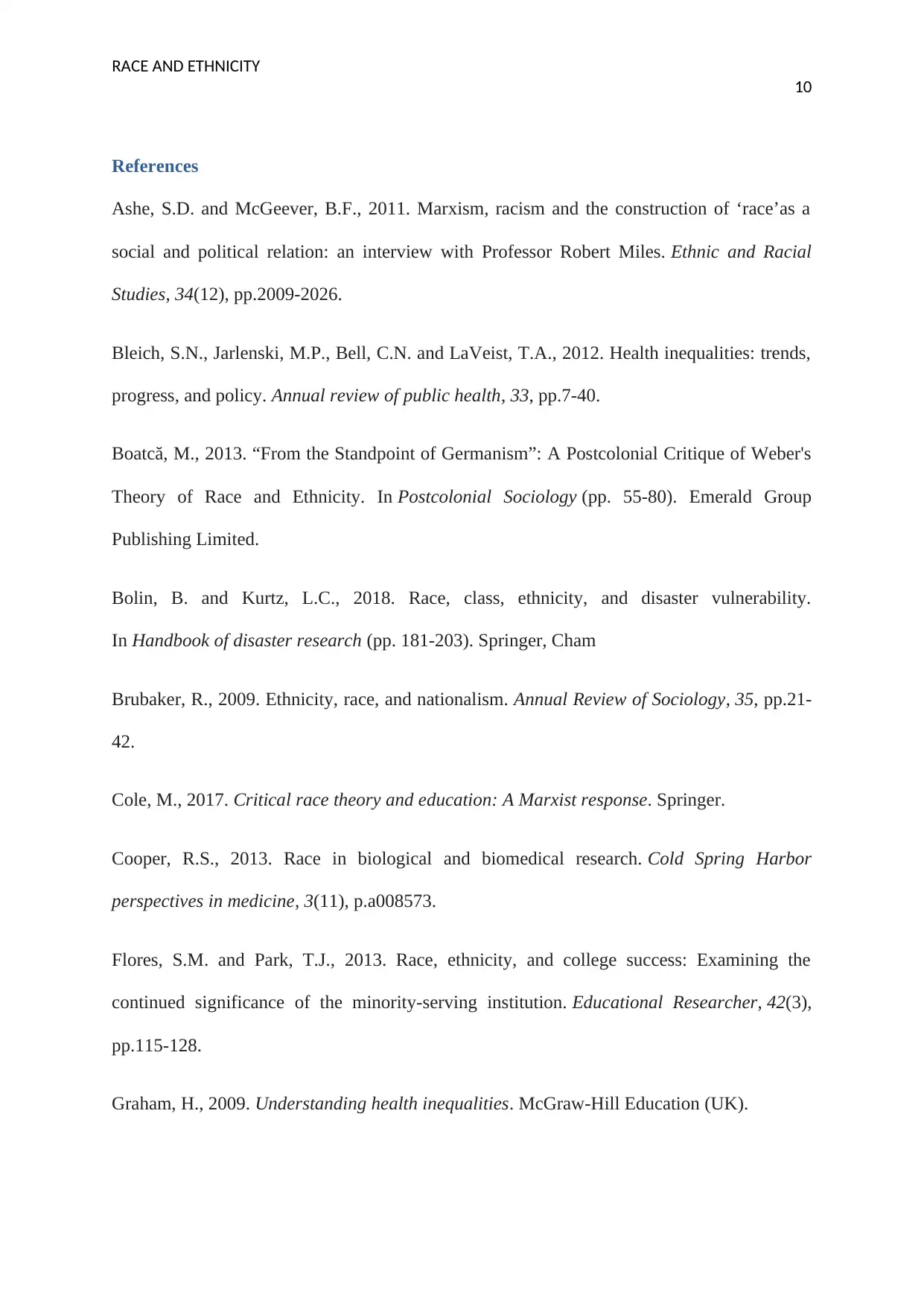
RACE AND ETHNICITY
10
References
Ashe, S.D. and McGeever, B.F., 2011. Marxism, racism and the construction of ‘race’as a
social and political relation: an interview with Professor Robert Miles. Ethnic and Racial
Studies, 34(12), pp.2009-2026.
Bleich, S.N., Jarlenski, M.P., Bell, C.N. and LaVeist, T.A., 2012. Health inequalities: trends,
progress, and policy. Annual review of public health, 33, pp.7-40.
Boatcă, M., 2013. “From the Standpoint of Germanism”: A Postcolonial Critique of Weber's
Theory of Race and Ethnicity. In Postcolonial Sociology (pp. 55-80). Emerald Group
Publishing Limited.
Bolin, B. and Kurtz, L.C., 2018. Race, class, ethnicity, and disaster vulnerability.
In Handbook of disaster research (pp. 181-203). Springer, Cham
Brubaker, R., 2009. Ethnicity, race, and nationalism. Annual Review of Sociology, 35, pp.21-
42.
Cole, M., 2017. Critical race theory and education: A Marxist response. Springer.
Cooper, R.S., 2013. Race in biological and biomedical research. Cold Spring Harbor
perspectives in medicine, 3(11), p.a008573.
Flores, S.M. and Park, T.J., 2013. Race, ethnicity, and college success: Examining the
continued significance of the minority-serving institution. Educational Researcher, 42(3),
pp.115-128.
Graham, H., 2009. Understanding health inequalities. McGraw-Hill Education (UK).
10
References
Ashe, S.D. and McGeever, B.F., 2011. Marxism, racism and the construction of ‘race’as a
social and political relation: an interview with Professor Robert Miles. Ethnic and Racial
Studies, 34(12), pp.2009-2026.
Bleich, S.N., Jarlenski, M.P., Bell, C.N. and LaVeist, T.A., 2012. Health inequalities: trends,
progress, and policy. Annual review of public health, 33, pp.7-40.
Boatcă, M., 2013. “From the Standpoint of Germanism”: A Postcolonial Critique of Weber's
Theory of Race and Ethnicity. In Postcolonial Sociology (pp. 55-80). Emerald Group
Publishing Limited.
Bolin, B. and Kurtz, L.C., 2018. Race, class, ethnicity, and disaster vulnerability.
In Handbook of disaster research (pp. 181-203). Springer, Cham
Brubaker, R., 2009. Ethnicity, race, and nationalism. Annual Review of Sociology, 35, pp.21-
42.
Cole, M., 2017. Critical race theory and education: A Marxist response. Springer.
Cooper, R.S., 2013. Race in biological and biomedical research. Cold Spring Harbor
perspectives in medicine, 3(11), p.a008573.
Flores, S.M. and Park, T.J., 2013. Race, ethnicity, and college success: Examining the
continued significance of the minority-serving institution. Educational Researcher, 42(3),
pp.115-128.
Graham, H., 2009. Understanding health inequalities. McGraw-Hill Education (UK).
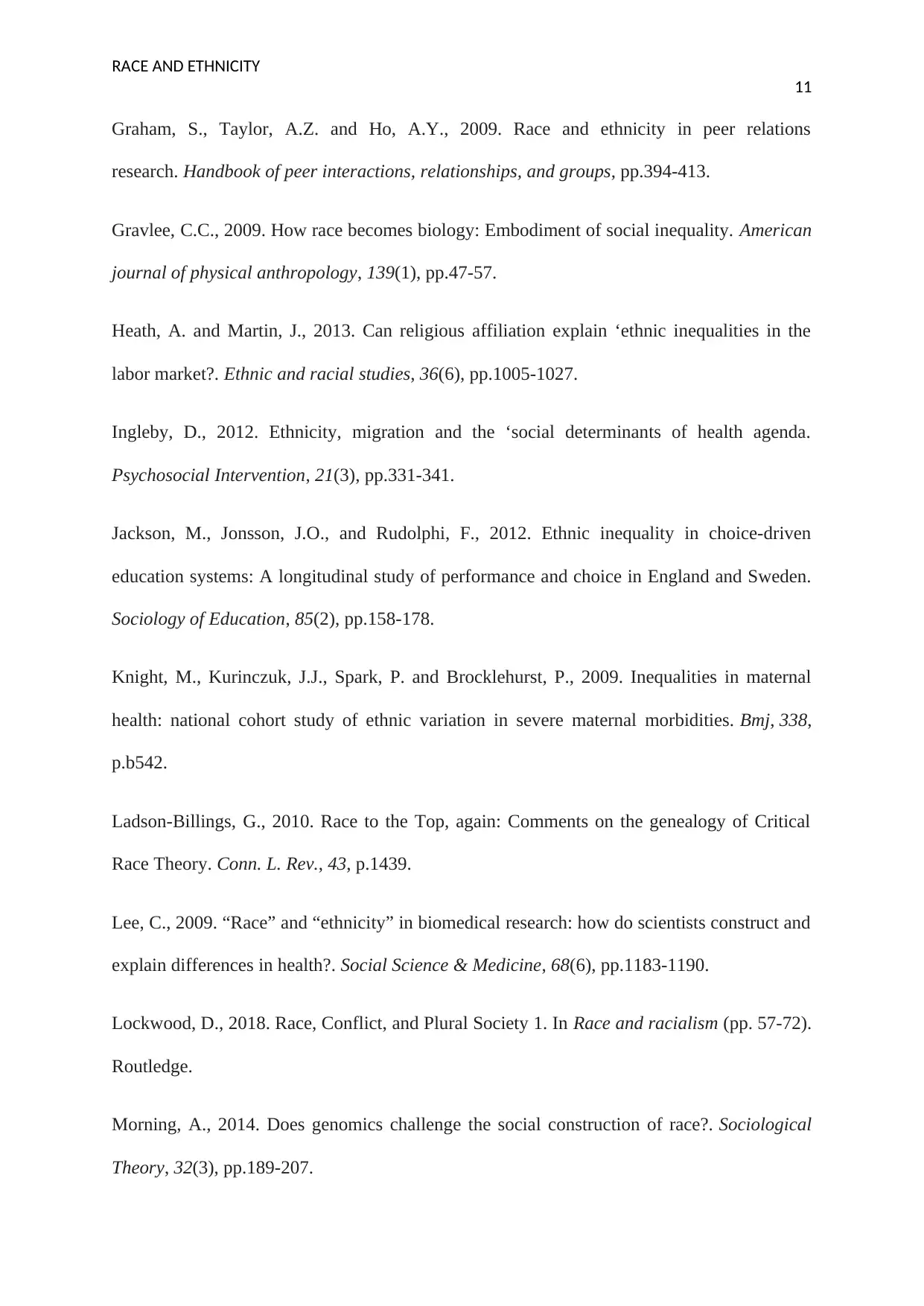
RACE AND ETHNICITY
11
Graham, S., Taylor, A.Z. and Ho, A.Y., 2009. Race and ethnicity in peer relations
research. Handbook of peer interactions, relationships, and groups, pp.394-413.
Gravlee, C.C., 2009. How race becomes biology: Embodiment of social inequality. American
journal of physical anthropology, 139(1), pp.47-57.
Heath, A. and Martin, J., 2013. Can religious affiliation explain ‘ethnic inequalities in the
labor market?. Ethnic and racial studies, 36(6), pp.1005-1027.
Ingleby, D., 2012. Ethnicity, migration and the ‘social determinants of health agenda.
Psychosocial Intervention, 21(3), pp.331-341.
Jackson, M., Jonsson, J.O., and Rudolphi, F., 2012. Ethnic inequality in choice-driven
education systems: A longitudinal study of performance and choice in England and Sweden.
Sociology of Education, 85(2), pp.158-178.
Knight, M., Kurinczuk, J.J., Spark, P. and Brocklehurst, P., 2009. Inequalities in maternal
health: national cohort study of ethnic variation in severe maternal morbidities. Bmj, 338,
p.b542.
Ladson-Billings, G., 2010. Race to the Top, again: Comments on the genealogy of Critical
Race Theory. Conn. L. Rev., 43, p.1439.
Lee, C., 2009. “Race” and “ethnicity” in biomedical research: how do scientists construct and
explain differences in health?. Social Science & Medicine, 68(6), pp.1183-1190.
Lockwood, D., 2018. Race, Conflict, and Plural Society 1. In Race and racialism (pp. 57-72).
Routledge.
Morning, A., 2014. Does genomics challenge the social construction of race?. Sociological
Theory, 32(3), pp.189-207.
11
Graham, S., Taylor, A.Z. and Ho, A.Y., 2009. Race and ethnicity in peer relations
research. Handbook of peer interactions, relationships, and groups, pp.394-413.
Gravlee, C.C., 2009. How race becomes biology: Embodiment of social inequality. American
journal of physical anthropology, 139(1), pp.47-57.
Heath, A. and Martin, J., 2013. Can religious affiliation explain ‘ethnic inequalities in the
labor market?. Ethnic and racial studies, 36(6), pp.1005-1027.
Ingleby, D., 2012. Ethnicity, migration and the ‘social determinants of health agenda.
Psychosocial Intervention, 21(3), pp.331-341.
Jackson, M., Jonsson, J.O., and Rudolphi, F., 2012. Ethnic inequality in choice-driven
education systems: A longitudinal study of performance and choice in England and Sweden.
Sociology of Education, 85(2), pp.158-178.
Knight, M., Kurinczuk, J.J., Spark, P. and Brocklehurst, P., 2009. Inequalities in maternal
health: national cohort study of ethnic variation in severe maternal morbidities. Bmj, 338,
p.b542.
Ladson-Billings, G., 2010. Race to the Top, again: Comments on the genealogy of Critical
Race Theory. Conn. L. Rev., 43, p.1439.
Lee, C., 2009. “Race” and “ethnicity” in biomedical research: how do scientists construct and
explain differences in health?. Social Science & Medicine, 68(6), pp.1183-1190.
Lockwood, D., 2018. Race, Conflict, and Plural Society 1. In Race and racialism (pp. 57-72).
Routledge.
Morning, A., 2014. Does genomics challenge the social construction of race?. Sociological
Theory, 32(3), pp.189-207.
⊘ This is a preview!⊘
Do you want full access?
Subscribe today to unlock all pages.

Trusted by 1+ million students worldwide
1 out of 13
Related Documents
Your All-in-One AI-Powered Toolkit for Academic Success.
+13062052269
info@desklib.com
Available 24*7 on WhatsApp / Email
![[object Object]](/_next/static/media/star-bottom.7253800d.svg)
Unlock your academic potential
Copyright © 2020–2025 A2Z Services. All Rights Reserved. Developed and managed by ZUCOL.




